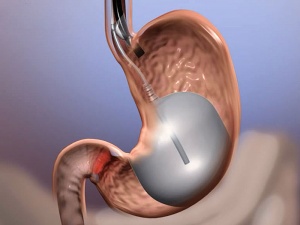 An intragastric (or gastric) balloon is an inflatable medical device used to aid in weight loss. In a non-invasive medical procedure, the intragastric balloon is placed into the stomach on a temporary basis in selected obese or overweight patients when diet and exercise have failed. One such device is the ORBERA Intragastric Balloon, which is made of soft silicone. The ORBERA Intragastric Balloon can be beneficial to patients because it stays in the stomach temporarily, about six months, during which time it encourages a patient to eat a healthier diet. Following is more information from top gastroenterologists in Queens regarding the ORBERA Intragastric Balloon that may assist you in making an informed decision concerning this noninvasive weight loss surgery. If you are interested in learning more about non invasive weight loss procedures contact a gastroenterologist near you.
An intragastric (or gastric) balloon is an inflatable medical device used to aid in weight loss. In a non-invasive medical procedure, the intragastric balloon is placed into the stomach on a temporary basis in selected obese or overweight patients when diet and exercise have failed. One such device is the ORBERA Intragastric Balloon, which is made of soft silicone. The ORBERA Intragastric Balloon can be beneficial to patients because it stays in the stomach temporarily, about six months, during which time it encourages a patient to eat a healthier diet. Following is more information from top gastroenterologists in Queens regarding the ORBERA Intragastric Balloon that may assist you in making an informed decision concerning this noninvasive weight loss surgery. If you are interested in learning more about non invasive weight loss procedures contact a gastroenterologist near you.
Why ORBERA Intragastric Balloon?
ORBERA is a durable gastric balloon that helps your body adapt to smaller, healthier portions at mealtime. Its volume and shape take up just enough space within your stomach to help you make better decisions regarding the portion sizes you eat. ORBERA can help overweight or obese patients lose up to three times more weight than if diet and exercise are used alone. It works by making you feel fuller faster.
What are the benefits?
The benefits of ORBERA are obvious: you feel fuller faster, you eat less, you lose weight. And, when obese patients lose weight, their risks of developing diseases related to obesity such as heart disease and type 2 diabetes greatly diminish.
 What is the procedure?
What is the procedure?
The procedure is performed in an endoscopy unit on an outpatient basis under sedation. During the procedure, the doctor will advance a catheter (thin tube) loaded with the intragastric balloon down your throat into your stomach, following which a tiny camera (endoscope) will be advanced down your throat in order for your doctor to see the balloon. The procedure takes only approximately a half hour, and patients typically go home several hours afterward.
What are the risks?
The most significant risks or side effects from the procedure are that about one-third of all patients have pain and nausea soon after insertion of the intragastric balloon. These symptoms, however, typically only last for a few days, and they can be treated with oral medications. Serious risks are rare and include balloon deflation potentially causing digestive blocking, as well as ulcer possibly requiring surgery.
Is it right for you?
While some weight loss surgeries may be right for some, they can prove too invasive for many patients who do not wish to undergo surgery. Additionally, many obese or overweight patients may not receive their doctors’ recommendation for such invasive weight loss surgeries, while they may receive it for the ORBERA Intragastric Balloon. If you are considering weight loss surgery but don’t relish the idea of undergoing an invasive procedure or a long recovery period, an intragastric balloon may be right for you. The fact is that losing weight can effectively lower your risk of developing serious health problems. Some of these include:
- High blood pressure
- Type 2 diabetes
- Heart disease
- Stroke
- Sleep apnea
- Digestive disorders
If you’re overweight or obese and you’re considering weight loss surgery, it’s a good idea to talk with your doctor regarding your risk for weight-related diseases, especially if your body mass index (BMI) is above 30. The ORBERA intragastric balloon can be helpful for people whose BMI falls in the range of 30 and 40, but it’s important to know that this is a not a quick fix. You must be willing to commit to pursuing a healthier lifestyle. This would involve the following: (1) making certain dietary changes, especially reducing portions; (2) including exercise in your routine; and (3) following up with regular medical checkups and perhaps even behavioral therapy. It’s important to know that intragastric balloons are not right for everyone who is overweight. If you have not had previous esophageal or stomach surgeries, see your doctor to undergo the screening process to decide if the ORBERA intragastric balloon is your answer to a slimmer, healthier body.
Everyone who has ever tried it knows that losing weight isn’t easy. Even the best of weight loss intentions and attempts can go awry pretty quickly. If you’ve tried a number of other diet, exercise, and weight loss programs, you likely have thought about weight loss surgery. However, weight loss surgery can be invasive and it often includes a long recovery period. Therefore, weight loss surgery may not be the answer for you. If you’re looking for a less invasive procedure, intragastric balloon may be the answer. Contact a gastroenterologist in Queens for more information about the ORBERA Intragastric Balloon.


